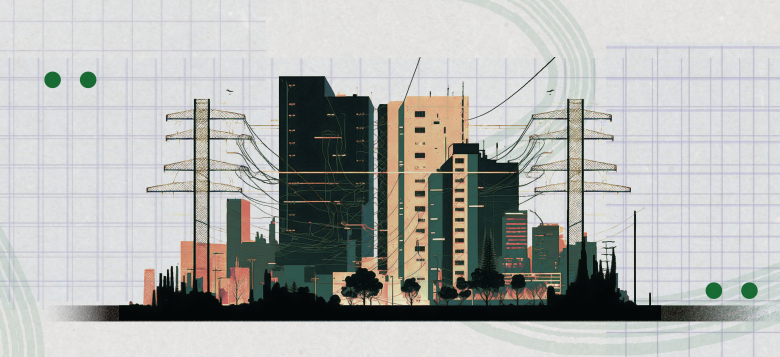2024: The year of grid technology

The electrical grid, a system of towers, cables, and transformers, has provided power to our homes and offices for more than a century. But as renewable energy generation increases, the grid faces major disruptions, raising concerns that it will struggle to cope.
A recent report from the International Energy Agency (IEA) warned that the state of the electricity grid could hinder the transition to clean energy. It says there is an urgent need to upgrade both the physical infrastructure of the power grid and how it is managed.
Across Europe, startups are working on solutions to adapt power grids to the influx of renewable energy.
problem
“For the first 125 years, the electricity grid was fine because electricity demand was very predictable,” says Paul Domjan, co-founder of Enoda, an Edinburgh-based company working on electricity grid solutions. Masu.
As well as predictable demand, our supply also comes from fossil fuels and is easily scaled up and down depending on demand. To avoid damage to infrastructure, the power grid must maintain the same frequency (approximately 50 hertz).
Now, with things like electric cars and heat pumps, demand is much less predictable. On the supply side, renewable energy sources such as wind and solar cannot be turned on and off on command to meet demand.
Despite all the changes, the grid remains the same. “We still have the exact same system that William Stanley, Nikola Tesla and George Westinghouse built,” Enoda’s Domjan says.
In some parts of Europe, a lack of balancing capacity in the electricity grid has made it impossible to introduce new sources of renewable generation. Balancing the electricity grid is already extremely expensive, and in the UK it will cost £5.6 billion in 2022 alone, with the cost entirely borne by consumers.
Physical solution: battery
Battery storage is one of the simplest solutions to this problem. Batteries can store energy when demand is low and release it when demand is high, and the number of companies working on battery storage has increased significantly in the last year.
Kaktos, a Finnish startup building battery energy storage systems, announced on January 10 that it has raised €26 million. Cactos supplies battery storage systems to industrial companies and builds systems that support the stability of broader power transmission systems.
“Batteries and energy storage are technologies that will ultimately provide people with stable electricity prices,” said Oskali Jaakola, founder and CEO of Cactos.

British battery storage company Field raised £200m last year, while Swedish start-up Ingrid Capacity last year secured $100m in a mix of equity and asset financing for a large-scale battery storage facility.
Chief strategy officer and co-founder Niklas Becker said Ingrid Capacity has focused on Sweden’s electricity grid since its launch in 2022, but is now aiming to expand across Europe. .
“When you have a lot of intermittent energy in your system, you need a battery to some extent to smooth out the imbalance that occurs,” Becker says.
Companies that provide battery energy storage systems often have contracts with the power grid to act as Balancing Responsible Persons (BRPs), who are responsible for helping correct grid imbalances. You can also trade your energy on the European wholesale energy market and, in some cases, use intermediaries such as large energy companies to trade your stored energy.
Software Solution: Aggregator
Other startups are combining hardware and software to maintain balance in the grid.
Dutch startup Sympower works in partnership with companies that use large amounts of energy. You can access some energy assets and turn them on or off when you need to balance the grid. Sympower aims to provide large amounts of balancing capacity to the grid by aggregating the demands of multiple companies.
Companies are compensated by the grid for acting as a reserve regulating capacity and pay additional compensation when actually needed.
Other companies, such as Norwegian-Swedish startup Tibber, are leveraging residential energy assets to bring flexibility to the grid.
“We were the first operator to start leveraging consumption flexibility for the Swedish electricity grid,” says Tibber co-founder Daniel Linden. Initially, Tibber used customers’ electric vehicles to balance the power grid. Electric vehicles act as small batteries that provide and store energy. Tibber now also integrates heat pumps, solar panels and home batteries.
Future regulations could accelerate grid technology
Some countries have allowed grid flexibility for longer than others. Britain has always been a leader. Greece opened its flexibility market last year, and industry insiders expect Poland to do the same this year.
Despite being a leader in battery production, Sweden is one of the countries that has been slow to implement grid flexibility mechanisms. Companies wishing to act as flexibility partners in Sweden will have to go through an intermediary, but from May this year they will be able to interact directly with the grid.
Ingrid Capacity’s Bäcker says Sweden’s new regulations will significantly increase the number of software companies that can balance the power grid.

Some people are less sure whether this change will have an impact. John Dyclef, founder of energy flexibility startup Flower, says the regulations don’t go far enough. “If you look at more mature markets like the UK and Germany, you see that value creation from support services to the grid is moving towards energy procurement. Sweden’s new regulations don’t allow that yet.” says Diclef.
Uniformity across grid networks is also important to the founders of the flexibility sector. Finnish startup Capalo AI, which operates energy storage batteries next to wind and solar farms, is expanding first to Sweden because of similar regulations to Finland.
“One of the reasons we chose Sweden is because the Nordic market is quite similar and we have the same permits as Finland and Denmark,” says founder Henri Taskinen. “It’s an easier job than going from here to Germany, for example.”
change the grid itself
As interest in grid innovation grows, companies are also beginning to work on technologies that change elements of the grid itself.
Edinburgh-based Enoda makes equipment to replace transformers and other components in distribution substations (where high-voltage current from the main electricity grid is converted to lower voltages suitable for domestic use).
“This ensures that the load appears to be perfectly balanced, regardless of what kind of energy selection is being made on the broader network, and vice versa, problems with the distribution network It ensures that the broader network is not affected,” he says. Paul Domjan, co-founder of Enoda.
And as investors focus on the potential of grid technology and its central role in the transition to renewable power, we are likely to see more solutions emerge and larger ticket rounds in the space. there is.
“There’s this idea that the power grid is just wires, and if you connect something to it, it works. It used to be that way,” Domjan says. “But that’s not the case now.”
Source link




